5 Best Cameras for Bird Photography in 2025 – Reviews & Top Picks
Last Updated on
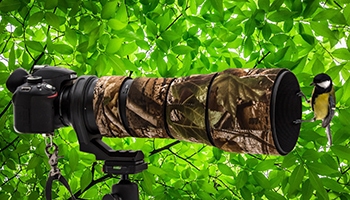
If you’ve ever experienced the disappointment of going through your shots after a long weekend of photographing majestic birds, only to find that the most artistic image of the bunch was wasted, you’re probably in the market for a new camera. Many things can cause this problem such as poor autofocus, lack of image stabilization, or just poor image quality from an underperforming device. Sensors, megapixels, autofocus, ISO; it can all get a bit confusing if you’re not an expert. We’ve been on the hunt for the perfect camera to capture all things avian, and the following five reviews were our favorites of those we’ve tested. In the buyer’s guide, we’ll go over all the important things to keep in mind when picking your new camera and simplify the terms that tend to be most confusing.

A Quick Comparison of Our Favorites in 2025
| Image | Product | Details | ||
|---|---|---|---|---|
| Best Overall |
 |
Nikon D500 Digital SLR Camera |
|
CHECK PRICE |
| Best Value |
 |
PANASONIC LUMIX FZ1000 Shoot Camera |
|
CHECK PRICE |
| Premium Choice |
 |
Sony a99II Digital SLR Camera |
|
CHECK PRICE |
 |
Canon EOS Digital SLR Bird Camera |
|
CHECK PRICE | |
 |
Canon EOS Digital SLR Bird Camera |
|
CHECK PRICE |
The 5 Best Cameras for Bird Photography
1. Nikon D500 Digital SLR Camera – Best Overall
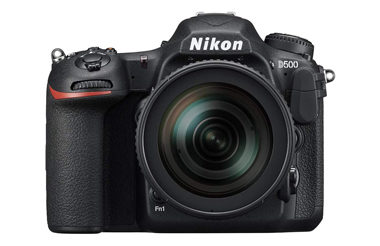
It’s no secret that birds don’t do a lot of sitting still. Thankfully, the 153 autofocus points of the Nikon D500 will ensure that every picture you take is crisp and perfectly focused. This meant we never had to experience the disappointment of that almost perfect shot ruined by poor focus, even when capturing a moving target. The D500 features an incredible ISO range that allows you to boost the brightness of your picture without introducing any grain, which is ideal for taking photos at dusk, dawn, or in low-light areas.
Thanks to the 20.9 DX-format sensor, every picture has incredible clarity and resolution. Even better, this sensor allows for a more streamlined camera set-up, instead of lugging around a big and bulky neck-weight while searching for your next flying subject. Moreover, this sensor is compatible with all NIKKOR lenses, giving you plenty of selection for maximum artistic expression. That said, lenses aren’t cheap and you’ll have to consider the camera, which isn’t cheap, either. However, it’s water and drop resistant. Since you’ll often be out in nature with this camera, you can expect it to survive many bird-seeking adventures.
All in all, we think that this is the best camera for bird photography this year.
- 9-MP DX-Format CMOS Sensor
- Can use all NIKKOR lenses
- Water and drop resistant
- 153-point autofocus system
- Great ISO range for low-light photography
- Does not include lenses
- Expensive + cost of lenses
2. PANASONIC LUMIX FZ1000 Shoot Camera – Best Value

Thanks to its ease-of-use and all-in-one capability at an affordable price, we think the Panasonic Lumix FZ1000 is one of the best cameras for bird photography for the money. The built-in lens did everything we hoped and we were impressed with its overall performance. The biggest problem with most point and shoot cameras is that they don’t have a low enough aperture to give control of effects like bokeh. Thankfully, the wide 2.8 aperture on this lens allowed us great creative control of our shots. On the upside, you’ll never have to lug around extra lenses to be prepared.
The FZ1000 zooms from 25mm all the way to 400mm, so you can easily get close-ups and far off pictures with stunning clarity. With such impressive zoom capabilities, shaky hands can start to become an issue. We never had any problems with this though, thanks to the 5-axis optical image stabilization, which worked like a charm and kept our shots clear and focused. Equipped with a large one-inch sensor, you’ll get incredible resolution, plus excellent low-light performance.
- Very affordable
- All-in-one – no separate lenses needed
- Large 1” sensor has great low-light capabilities
- Wide 2.8 aperture lens allows flexibility
- 5-axis O.I.S.
- Can’t change lenses
3. Sony a99II Digital SLR Camera – Premium Choice
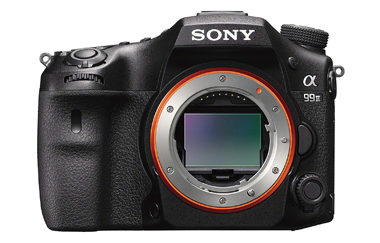
Because they capture a larger image in higher resolution with more light, full-frame sensors are the cream of the crop. They take incredibly crisp and clear images with top-notch low-light performance. Of course, you’re going to pay a premium for that performance, and the Sony A99II is no exception. Remember that you’ll also need to invest in lenses. On top of the full-frame sensor, the incredible autofocusing capabilities mean you’ll see your shots in a whole new way, clearer than ever before. The 5-axis in-body image stabilization helps this even more, ensuring that shaky hands won’t ruin your shot.
Shooting a moving subject? This camera can snap 12 frames per second in perfect clarity, ensuring you’ll never miss a shot just because your finger doesn’t click fast enough! We were also impressed with the 4K capabilities of the Sony. The video quality is magnificent, and since it shoots at 100 MB/s quality, we were able to pull beautiful 8MP still images from the videos. This is one of the most capable cameras we’ve seen, and if you’re willing to cough up the investment, it should help take your bird photography to a new level.
- Incredible autofocus
- Full frame sensor for incredible detail
- Top-notch low-light performance
- 5-axis in-body image stabilization
- 100 MB/s 4K video can pull still images
- Massive investment
- Lenses must be purchased separately
4. Canon 1483C002 EOS Digital SLR Bird Camera
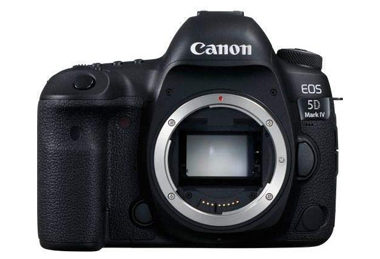
Tried and true, the Canon 5D Mark IV is a well-loved camera by many photographers and it’s easy to see why. The full-frame CMOS sensor provides incredible detail and exceptional low-light performance. Since we often find ourselves shooting when it’s getting close to sundown, we really appreciate that we can still capture excellent images even when light conditions are less than perfect. We also love the dual pixel autofocus. It’s known as one of the best available, and after testing, we believe the claim. It focuses so fast that even moving subjects are always shot with excellent clarity. This also performs just as well when taking 4K video at 30fps. When we pulled the 8.8MP still images from our 4K video, we were pleased to see the autofocus never failed.
Despite the great performance, it’s not quite up to par with our higher picks. For capturing birds in flight, we love to use the continuous shooting function; however, this one only takes 7 frames per second compared to 12 from the Sony. The screen is also completely stationary. Even the FZ1000 has a flip-out screen at a quarter of the cost.
- Full-frame CMOS sensor for incredible detail
- DCI 4K video at 30 fps with 8.8 MP still frames
- Dual pixel autofocus is fast and reliable
- The screen doesn’t flip or tilt
- Expensive + cost of lenses
- Only 7 fps continuous shooting
5. Canon 9128B126 EOS Digital SLR Bird Camera
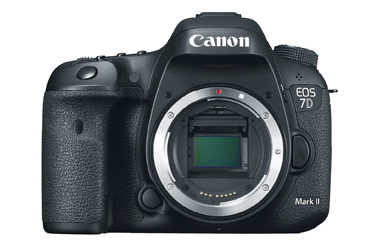
Nice and compact for a DLSR camera, the Canon EOS 7D Mark II was also surprisingly heavy at two pounds without a lens. It does feel great to hold thanks to its smaller size. We find that for bird photography, the viewfinder is often preferable to the screen, but this means you lose some control of your camera’s functions. Not so with the 7D, since all of your settings and shooting modes are visible and adjustable while using the viewfinder. The 20.2MP CMOS sensor holds this camera back compared to the others we tested. It doesn’t let in as much light or have the same level of resolution since the sensor is so much smaller. Low-light performance suffered as a result.
For continuous shooting, this camera can take up to 10 images per second. This was adequate, but the lack of 4K video was not. We like the ability to shoot video in 30fps and pull individual still images from the roll, especially when shooting birds mid-flight. Ever try to capture a hawk diving in for the kill? It pays to have as many frames as possible. It’s a bit overpriced for what you get, but it still performs well.
- Dual pixel autofocus is incredibly fast
- All settings available in the viewfinder
- Compact size
- Heavy – 2 lbs without lenses
- No 4K video
- Overpriced compared to competitors
- APS-C CMOS sensor

Buyer’s Guide
If you feel like there’s too much to consider, our buyer’s guide may help you to make sense of it all. There is a lot to know about cameras in general, and specifically, how each feature pertains to bird photography. After reading this section you should know exactly which features are most important and should be prioritized. Then we will summarize our recommendations again so you can go forth with all the knowledge necessary to pick the perfect camera to capture every feather of the in-flight action.
How Important are Megapixels?
The Megapixel ratings of cameras have multiplied over the last decade. 8MP used to be considered incredible at one point in time. Today, cameras can have 40+ megapixel capabilities. Even smartphones have become very capable cameras these days, often able to shoot 16MP+ images. But what does this really mean, and is this the most important metric for image quality?
A Megapixel is 1-million pixels. Each pixel represents a single photosite on your camera’s sensor, so a photosite is essentially a sensor for a single pixel. Therefore, a 16MP camera has 16,000,000 photosites and produces images with 16,000,000 pixels. With us so far?
APS-C Sensor vs. Full-frame Sensor
Let’s assume that two cameras have a 16MP rating but one of them has an APS-C sensor and the other has a full-frame sensor. The full-frame sensor is 2.4 times larger than the APS-C, but they have the same amount of photosites. This means that each photosite on the full-frame sensor is considerably larger than on the APS-C sensor. As such, each photosite on the larger sensor can take in more light. This results in improved dynamic range, superior low-light performance, and less noise in your images, especially in the areas with less light.
For bird photography, the improved dynamic range of a larger sensor can mean brighter and more vibrant colors that accurately portray what you witnessed. If you’ve ever noticed how grainy and unclear your images become when the sun starts to set, then you can understand how the improved low-light performance will positively affect your photos.
While Megapixels have been the advertising buzzword to sell cameras for quite some time, it’s clear that they aren’t the whole story.
Sensor Size
We began discussing sensor sizes while talking about Megapixels, but let’s get into it a bit deeper. If all sensors were created equal, then a modern smartphone camera would perform nearly as well as a multi-thousand-dollar professional camera setup. We know this isn’t true, even if a smartphone has a high Megapixel rating. This is because sensor size is king. Today’s highest-end smartphone cameras are equipped with 1/2.3″ sensors. This small sensor has a surface area that’s 35 times smaller than a full-frame sensor. This equals out to a crop factor of 6X, meaning the larger sensor takes in six times more light, even with the same amount of megapixels.
Camera sensors are still measured by their old-school film millimeter equivalent. A full-frame sensor is the same size as a 35mm film camera. As such, it has a crop factor of 1.0. Each smaller size sensor will be cropped accordingly, meaning it will capture fewer details and less light. For bird photography, you want the most vibrant colors possible with the least amount of grain in the image. A larger sensor will take in more light and have a higher dynamic range, which will reduce the grain and provide the greatest clarity and color reproduction. For these reasons, we suggest picking a camera with the largest sensor that’s in your budget.
Interchangeable Lenses vs. Point and Shoot
When it comes to creative expression in photography, lens selection makes the biggest difference. Smaller mm lenses will allow wider shots that take in more of the scene in front of you, while lenses with a higher mm measurement are better for telescopic photos and can capture a subject in great detail from far away. Zoom lenses can give you both options at once, but they tend to be limited in aperture.
Why is Aperture Important?
Aperture is a measurement of how open or closed the window of your lens is and it’s measured in f/stops. You may see a rating like f/2.8, which means the lens has a maximum aperture of 2.8. With aperture, the lower a number is, the more open the lens. Naturally, this means a lower aperture lets in more light. The effect is much greater than just a brighter image though. Adjusting aperture will allow you to achieve effects such as bokeh, which is the blurring of the background behind a clear subject in front. This allows you to create a specific focal point for the eyes to gravitate to and leads to very tasteful pictures.
With interchangeable lenses, you have absolute freedom to change to any lens with a specific viewing field and f/stop to achieve the perfect shot that’s in your mind’s eye. Of course, lenses can cost as much like cameras, so investing in several to lug around on top of your DSLR can be expensive as well as cumbersome. The extra bulk and weight of all those lenses can definitely start to wear you out when walking all day to find the perfect avian subjects. In steps the point and shoot camera.
A point and shoot camera has its lens built-in and it’s not changeable. Usually, these cameras will have a good zoom range that will allow for both wide-angle and close-up shots. However, the aperture may not reach a low enough f/stop for that creamy bokeh effect. Moreover, when shooting in low light, opening up the aperture can help remove grain from the image by allowing more light to enter. It’s going to be a tradeoff between portability, price, and creative control over your photography.
Autofocus
When capturing moving subjects, maintaining a clear focus can get difficult. Today’s cameras have many autofocus points to allow for the quickest target acquisition. Each camera has a certain number of autofocus points where it can detect a subject to focus on. Some have cross-focus points that are detecting movement horizontally and vertically in the same spot for even faster focusing. For bird photography, most modern higher-end cameras will have sufficient autofocus to capture clear images. If you’re like us and enjoy pulling your still images from 4K video, then you may want to find the camera with the most autofocus points possible to ensure every frame is in perfect focus.
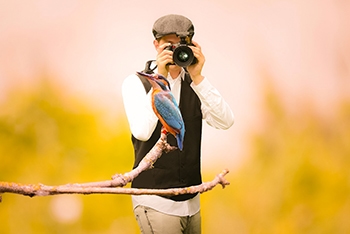
Capturing Birds Mid-Flight
Avian photography involves capturing moving subjects, and some of our favorite photos were snapped mid-flight. This can be incredibly difficult to achieve if you’re taking one photo for each press of the button. Modern digital cameras have some very effective ways of capturing images of moving targets, and these are excellent for photographing birds in flight.
Continuous shooting allows you to hold the button down to take photo after photo much faster than you could possibly press the button. Some of our favorites even managed 12 shots per second! Can you imagine doing that with your finger? We can’t! This is one great way to capture a bird in-motion since you’ll still get the full performance of your camera’s still images, but you’ll be able to snap dozens of photos in sequence.
Another way to get great shots of birds mid-flight is to utilize the 4K video capabilities present on many cameras. If the video quality is high enough, you should be able to pull any 4K video frame as a still image. With many cameras, the stills you can capture through this method are still extremely high quality, often over 8MP. If you’re having trouble capturing the action in still photos, try using this technique and see if you get better results.
Low-Light Performance
In a perfect world, we could shoot any camera anytime and get a beautiful image. As we all know, this is far from reality. Once light conditions are less than perfect, most cameras begin to introduce a lot of grain and noise to the image. Several factors play into this. Smaller sensors take in less light so they have poorer low-light performance. If your lens doesn’t open to a wide enough f/stop you may be limited in how much light your lens will allow reaching the sensor. A larger sensor and lower f/stop will both help get an image with less noise, but you can also use ISO.
ISO is an artificial brightening of the image within the camera body. Each camera will have a designated ISO range where it works best and a single ISO rating where the cleanest, clearest pictures will be taken. Some cameras have impressive ISO capabilities that will allow you to boost this number rather high without making your image grainy. If you plan on shooting in low-light often, look for a camera with a large sensor and a high ISO range.
Image Stabilization
How often are you snapping pictures of a bird that just a few feet away from you? It happens, but more often than not we’re using a telescopic lens and capturing images of birds that are quite a bit farther away. The more zoomed in a lens is, the more noticeable any movement will be in the final image. It’s nearly impossible to hold a camera perfectly still by hand, and not everyone wants to lug a heavy tripod around with them, then set it up and wait for the perfect shot. If you like to shoot more spontaneously, then you need image stabilization.
Image stabilization accounts for any shaking or movement of the camera when the image is taken. If you compare a stabilized image versus a non-stabilized image, the difference is night and day. Granted, the stabilization does require minor cropping of the image, but this is all done in-camera. Image stabilization is also available for shooting video. This means that capturing that hawk dive-bombing its prey in beautiful 4K glory will produce epic still images that are still perfectly in focus. Try doing that with the press of a button!

Conclusion:
When picking a camera for bird photography, there’s almost as much to keep in mind as there are avian species! That’s an exaggeration, but it can be very confusing. Hopefully, between our reviews and buyer’s guide, you feel prepared to go and pick the best camera to accompany you on your bird-seeking adventures. Before that, we’re going to quickly summarize our recommendations. The Nikon D500 was our top pick that we recommend for a majority of bird photographers. It’s water and drop resistant to survive out in nature. The excellent ISO range makes low-light photography feasible and the 153-point autofocus system ensures every shot is clear.
Looking for the best bang for your buck? We suggest checking out the Lumix FZ1000 point and shoot camera. It’s very affordable and since the lens is built-in you won’t have to make any extra purchases. The large one-inch sensor gives incredible resolution and low-light performance and the 5-axis O.I.S. ensures each image is clear and crisp. This makes it the best camera for bird photography for the money. If performance is more important than money to you, the Sony A99II is our premium recommendation. The full-frame sensor can’t be beaten for detail and low-light performance, plus the in-body image stabilization eliminates blur from shaking.
We hope that you enjoyed our article. We wish you good luck with finding the best bird photography camera!
You might also be interested in: Camcorder vs Camera: Which Is Better for Your Needs?
About the Author Robert Sparks
Robert’s obsession with all things optical started early in life, when his optician father would bring home prototypes for Robert to play with. Nowadays, Robert is dedicated to helping others find the right optics for their needs. His hobbies include astronomy, astrophysics, and model building. Originally from Newark, NJ, he resides in Santa Fe, New Mexico, where the nighttime skies are filled with glittering stars.
Related Articles:
How to Clean a Refractor Telescope: Step-by-Step Guide
How to Clean a Telescope Eyepiece: Step-by-Step Guide
How to Clean a Rifle Scope: 8 Expert Tips
Monocular vs Telescope: Differences Explained (With Pictures)
What Is a Monocular Used For? 8 Common Functions
How to Clean a Telescope Mirror: 8 Expert Tips
Brightfield vs Phase Contrast Microscopy: The Differences Explained
SkyCamHD Drone Review: Pros, Cons, FAQ, & Verdict



